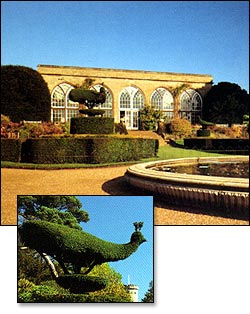|
The beautifully proportioned conservatory, which acts as a focal point in the landscape, was built in 1786 by a local mason, William Eborall.
Originally, it was designed as a home for the Warwick Vase, a magnificent piece of ancient Roman pottery excavated near Tivoli in 1771.
The original vase is now on display at the Burrell Collection in Glasgow. There is, however, a full-size replica standing in the conservatory, which has since been converted back to its
Victorian use as an ornamental glasshouse for growing exotic plants.
Directly in front of the conservatory is the Peacock Garden, designed by the Victorian landscape gardener Robert Marnock.Just to the south-east is a
group of trees that includes a Wellingtonia planted by Prince Albert in 1858. Queen Victoria also planted an oak which stands close to the driveway from
the courtyard. Just 18.3 metres from this magnificent oak is a young oak tree which was planted on 1st January 2000 to celebrate the coming of a new century.
Running gently down to the river is Pageant Field, flanked on either side by trees, of which some, like the Cedars of Lebanon, are over 200 years old
|
